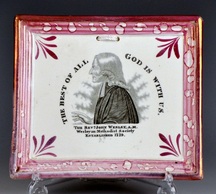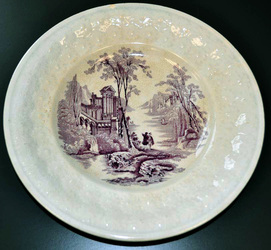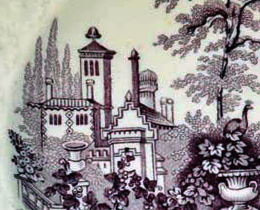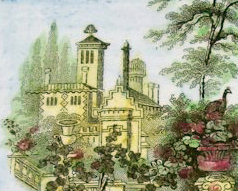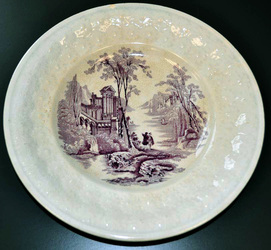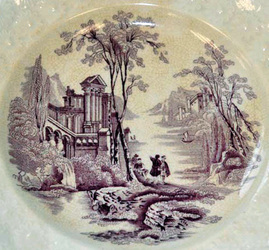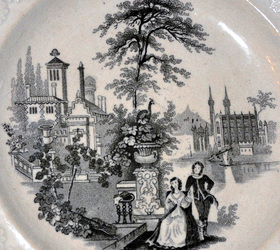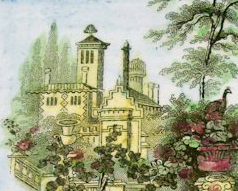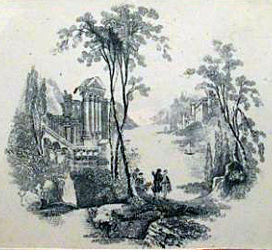|
1/19/2013 0 Comments Plaque values, then and nowIt might be diverting/depressing (delete as applicable) to look back at the prices fetched by plaques when the market was strong. The data come from Miller's price guide, so the prices need to be approached with some caution. Miller's valuations fluctuate widely depending on whether they come from a dealer or an auction house. All of the valuations below were supplied by dealers. N.B. the plaques below are similar to those show in Miller's, but may vary slightly in terms of condition. The valuation for a circular Stockton 'Prepare' plaque was £220-250 in 2005. The frequency with which these plaques appear on the internet (I'd guess 2–3/year) has shown that they aren't as rare as once supposed. However, rarity is relative. Compare that with red and white Staffordshire dogs (Wally dogs if you're Scottish), which come up in dozens every month. You can buy the plaque above on my Exchange page for £100. The John Carr-attributed plaque above is a particularly fine example. Miller lists a similar plaque for £300-350 in 2005. You can buy a fine 'Prepare' plaque from the same series for £155 on Ian Sharp's website. A plaque similar to the above is valued in Miller's 2004 guide as £430-475. That valuation seemed fanciful even at the time of publication. I have listed this transfer on my Common ships page, but how common is common? A whole year might pass without seeing one, and then three might sail by at once. In 2004, when these Scott-attributed ship plaques came up on eBay, there would be four or five bidders chasing them. But now that all the established collectors have one, and with few new collectors emerging, the price has dropped. There is one on eBay currently, for Buy it Now £250. It already has two offers. The above John Wesley plaque is earlier and rarer, and this is where it starts to get interesting. Miller's 2004 guide values a similar plaque for £400-450. You might see one or two of these come up for sale every 5 years or so. John Howard currently has one with its Adam Clarke pair for £775. Wesley plaques remain popular amongst Methodist collectors. Finally, a very rare plaque, like the one above, was listed in Miller's 2000 guide for £450-500. I haven't seen one on the market since. That valuation for a perfect example seems quite reasonable by today's standards. It is safe to assume there would be a lot of interest if one of these appeared on the internet. So even in hard times, rare things keep their value. But until the Ikea generation gets fed up with flat-pack furniture, laminate floors and plastic fruit bowls, there has never been a better time to start a collection of plaques.
0 Comments
I got pretty excited when the plates below, with impressed 'J CARR & Co' marks came up at Anderson and Garland last year. I felt sure I'd seen the transfers on plaques. I've set the plates and plaques side-by-side below, along with details of the transfers. It would have been great to get a cast-iron attribution for the plaques as John Carr. I'll let you play spot the difference, but I'm certain they come from different transfer plates. If you are in any doubt, look at the lozenge decoration on the building on the left in the final detail (click to enlarge and move between the images). The differences between the second plate and plaque with similar transfer are even more pronounced. Note the shadows on the water to the right of the figures. I felt a bit crestfallen, but then remembered a pair of plates in a pile in my bedroom that I bought some time ago (thanks to Philip Rutherford for drawing my attention to them on eBay). The plates have similar transfers and the LONDON impressed mark over an anchor (see below). Given the angle of the plaque photos and the washes of enamels over the plaque's transfer, it is difficult to be 100% certain, but these look like a good match to me. (Remember the lozenges on the left house in the third detail.) Again with the second plate it is impossible to be certain (the transfer on the plaque has degraded), but an altogether better match. So who made the plaques and the London-marked plates? Clarice Blakey states in a Northern Ceramic Society newsletter (83) that... The five reported users of the LONDON mark are: Middlesbrough Pottery, 1834–52 Isaac and Thomas Bell, Albion Pottery, 1860–63 Carr & Sons, Low Lights Pottery N. Shields, 1844–c 1900 Malkin, Walker and Hulse, British Anchor Pottery, Longton, 1858–64 Fell & Co, St Peters Pottery, Newcastle on Tyne, 1817–1890 My hunch is that both the plaques and the London-marked plates were made by John Carr, but the attribution is some way off being cast-iron. If you know better, please get in touch.
|
AuthorStephen Smith lives in London, and is always happy to hear from other collectors. If you have an interesting collection of plaques, and are based in the UK, he will photograph them for you. Free advice given regarding selling and dispersal of a collection, or to those wishing to start one. Just get in touch... Archives
February 2022
AcknowledgementsThis website is indebted to collectors, dealers and enthusiasts who have shared their knowledge or photos. In particular: Ian Holmes, Stephen Duckworth, Dick Henrywood, Norman Lowe, Keith Lovell, Donald H Ryan, Harold Crowder, Jack and Joyce Cockerill, Myrna Schkolne, Elinor Penna, Ian Sharp, Shauna Gregg at the Sunderland Museum, Keith Bell, Martyn Edgell, and Liz Denton.
|



